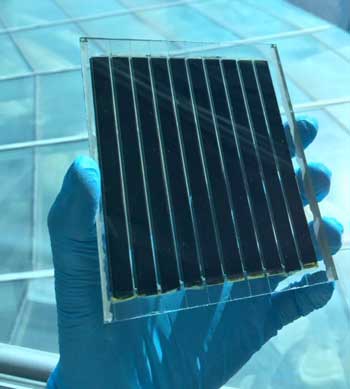| Oct 01, 2020 | |
Chemical innovation stabilizes best-performing perovskite formulation(Nanowerk News) Perovskites are a class of materials made up of organic materials bound to a metal. Their fascinating structure and properties have propelled perovskites into the forefront of materials' research, where they are studied for use in a wide range of applications. |
|
| Metal-halide perovskites are especially popular, and are being considered for use in solar cells, LED lights, lasers, and photodetectors. | |
| For example, the power-conversion efficiency of perovskite solar cells (PSCs) have increased from 3.8% to 25.5% in only ten years, surpassing other thin-film solar cells - including the market-leading, polycrystalline silicon. | |
| Perovskites are usually made by mixing and layering various materials together on a transparent conducting substrate., which produces thin, lightweight films. The process, known as "chemical deposition", is sustainable and relatively cost-effective. | |
 |
|
| A Large Perovskite Solar Cell. (Image: EPFL) | |
| But there is a problem. Since 2014, metal halide perovskites have been made by mixing cations or halides with formamidinium (FAPbI3). The reason is that this recipe results in high power-conversion efficiency in perovskite solar cells. | |
| But at the same time, the most stable phase of FAPbI3 is photoinactive, meaning that it does not react to light - the opposite of what a solar power harvester ought to do. In addition, solar cells made with FAPbI3 show long-term stability issues. | |
| Now, researchers led by Michael Grätzel and Anders Hafgeldt at EPFL, have developed a deposition method that overcomes the formamidinium issues while maintaining the high conversion of perovskite solar cells. | |
| The work has been published in Science ("Vapor-assisted deposition of highly efficient, stable black-phase FAPbI3 perovskite solar cells"). | |
| In the new method, the materials are first treated with a vapor of methylammonium thiocyanate (MASCN) or formamidinium thiocyanate FASCN. This innovative tweak turns the photoinactive FAPbI3 perovskite films to the desired photosensitive ones. | |
| The scientists used the new FAPbI3 films to make perovskite solar cells. The cells showed more than 23% power-conversion efficiency and long-term operational and thermal stability. They also featured low (330 mV) open-circuit voltage loss and a low (0.75 V) turn-on voltage of electroluminescence. |
| Source: Ecole Polytechnique Fédérale de Lausanne | |
|
Subscribe to a free copy of one of our daily Nanowerk Newsletter Email Digests with a compilation of all of the day's news. |
